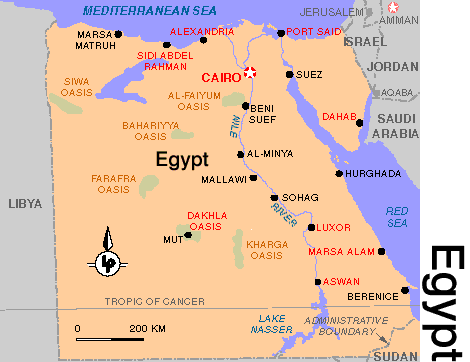
How exactly might the frontier fortresses have defended Egypt?
It does not seem likely that sufficient troops could have been stationed at any fortress to fight off invasion forces of the size apparently mustered under Merenptah and Ramesses III, which are said to number many thousands. Even if we accept that these figures are somewhat exaggerated in the records for effect, it is still unlikely that even a large fort, like Zawiyet Umm el-Rakham, could possibly have housed enough men to fight off even a fraction of the alleged number of individuals involved.
The Nubian Second Cataract fort at Mirgissa (click here for map or here for more details), a similar size to that at Zawiyet Umm el-Rakham, has been estimated to have housed between 600 and 1500 men (Smith 1991b:109, 130). Although such a sizable body of troops at Zawiyet Umm el-Rakham might have been able to prevent access to the fortress itself, it would seem unlikely that it could have stopped the inexorable progress of an even larger invasion force. In this case, what use would the fortress have been, it being possible for the Libyans simply to bypass it and its essentially impotent garrison walled up inside?

One possibility is that the fortresses protected something of strategic importance within, without which the Libyan forces may have been hindered in their march towards Egypt. Zawiyet Umm el-Rakham seems to hold the key as to what this might have been.
Upon the main gateway is an inscription that refers to the fortresses and "the wells which are within them" (Snape 1998:1083). Not only would a well inside the fort supply the personnel stationed there, but it would also prevent the hostile Libyans and their accompanying animals gaining access to vital water (Snape 1998:1084). If this is true of all the forts that might once have existed on the route into Egypt, one might expect to find them located at ancient water sources or along particularly well-watered routes, such as that around Lake Maryut.
To bypass these controls, perhaps the invaders (or at least some of them) chose the route that took them through the fertile Western Desert Oases (Davies 1997:1155-157). Despite the fact that by the 19th Dynasty the Oases were under Egyptian control and effectively part of the state administrative system, rule seems to have been rather loose (Giddy 1987:97). There is no evidence of any large military presence within the Oases despite their strategic location (Giddy 1987:96). For this reason, perhaps this route was seen as preferable and exploited as a bypass for the coastal fortresses.

In addition to protecting water sources, the coastal forts may have served as an early-warning system. If they were located a regular distance apart, say two day's march or a day's chariot ride (Kitchen 1982:71-72), at any sign of a large, but slow moving, enemy force, a message could be passed back down the chain to the Delta where a full army could be mustered to meet the threat.
It is also likely that regular patrols scouted the areas around the fortresses keeping watch for potential trouble. Similar surveillance systems are recorded for the southern frontier of the Middle Kingdom in the Semna Dispatches (Smither 1945) and perhaps in Papyri Anastasi III, V and VI for the eastern frontier of the New Kingdom (Caminos 1954:108-113, 269-273, 293-296).
A further function of the fortresses may have been to supply the armies who campaigned against the Libyans. Such a function has been proposed for the Second Cataract forts and those of the Ways of Horus where substantial granaries have been located (Kemp 1986:134; Oren 1987:82; Smith 1991b:117).
Beyond their military aspect, evidence is revealing that the fortresses played a wider role, exerting socio-economic controls over the region.